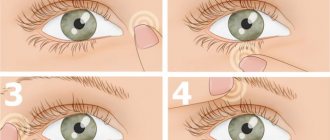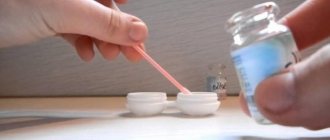Symptoms of a stuck lens
If the eye optics are installed correctly, they will not cause any discomfort. If it moves to the side, there will be a feeling of the presence of a foreign object in the eye.
If it ends up under the eyelid, the following unpleasant symptoms may appear:
- pain;
- fear of light;
- burning;
- lacrimation;
- deterioration of visual acuity when the contact means is shifted with diopters.
Since misaligned contact products interfere with the normal sliding of the eyelids, closing and opening them will be very difficult.
Why does it get lost, stuck and stuck?
Basically, problems with eye optics appear when there is insufficient experience in removing or fixing them on the cornea.
If it appears under the eyelid, it means:
- the wrong size was chosen;
- was installed at an angle;
- Placing the lens on the wrong side.
Sticking of the product occurs when the cornea is very dry or poorly treated with a salt composition. If you remove the product with wet fingers, it will slip off.
Not all models are suitable for evening sleep. Due to the formation of proteins on the lenses, they will stick to the cornea or eyelids at night. When you wake up, the eyelids will begin to slide over the eyeball, and the sticky area will pull the contact agent down or up, removing it from the cornea.
To prevent such situations from occurring, it is advisable to purchase eye optics after consultation with an ophthalmologist. After the examination, the doctor will be able to choose the optimal model, taking into account the structural features of the visual organs.
Once a year, it is recommended to conduct a preventive ophthalmological examination. If there are any diseases, the examination should take place much more often.
Algorithm of actions with soft contact lenses
Removing contact lenses is considered a simple process, which in the future will be brought to automaticity. Initially, problems may arise if the tool is positioned incorrectly. You can remove it yourself without visiting a specialist.
If you're stuck in a century
Experts will tell you how to get a lens out of your eye if it is stuck in your eyelid. They recommend initially making sure that the product is difficult to remove due to dry mucosa. Afterwards, you can take any means to extract it.
Algorithm for removing a soft contact lens:
- Apply moisturizing drops into the eye several times.
- Make circular movements with your eyeball, up and down, and also left and right.
- Thanks to the large volume of liquid, the product will remain in its original place and can be removed from the eye.
There are also several other methods for removing soft contact lenses:
| Way | How to do it |
| Using quality lighting and mirrors | The head should be thrown back high enough so that the chin area is horizontal. When lifting the upper eyelid by the eyelashes, you need to examine the area where the lens is located. To improve the result, you can use moisturizing drops while continuing to blink frequently. |
| Using special tweezers |
|
| Using plenty of water | 375 ml of cooled boiled water must be poured into a deep, clean, small container. The dishes need to be placed on the table, with your face lowered so that your eye is completely in the liquid. It is recommended to be completely relaxed during the procedure. While in the water, you need to open and close your eyes, blinking frequently. You can move the upper eyelid a little with your index finger. Due to this, the lens will be removed. |
| Using your hands | After instilling the eyeball, you need to lightly grab the skin of the upper eyelid with your index finger and thumb in the area where there is the largest depression in the orbit. In this case, the eye should be closed. It is required to perform not very fast gentle movements with your fingers along the eyeball from top to bottom. After opening your eyes, it is recommended to blink quickly. The procedure can be done several times until the product is completely cured. |
If it sticks
Doctors know how to remove a lens from an eye if it is stuck. They advise not to remove the product by force, as it can rub the eyeball or cause pain. It is prohibited to use any foreign objects that can be used to remove the product.
Step-by-step instructions for removing the soft eye contact product:
- Apply eye drops and wait a few minutes. Close your eyes and roll them around. Massage the eyelid. If there is no special composition, wash with running water.
- Close your eyes tightly several times. Roll your corneas, closing your eyes tightly. This will cause the lens to begin to shift.
- Move the product with a dry finger. If it is wet, use another one.
- The eye should rest for a few minutes, then repeat the above steps.
How to remove a lens from an eye
When performing the procedure, you need to be completely calm and not apply pressure. If you are unable to remove the product, you should allow your eyes to rest for a long period of time. At this time, the drops will penetrate under the product, diluting the sticky liquid. In this case, the outer surface of the product will become dry, which will make it not too elastic and quite mobile.
If after 20 min. If you were unable to remove the lens yourself during a rest break, you should seek help at the emergency room, where specialists will be able to remove the object.
If you're lost
Everyone who uses them should know how to get a lens out of the eye if it is lost in the eyeball. If there is no product in the right place, you should use eye drops that will allow the lens to appear. If a product is found, it should be immediately picked up and removed.
If you cannot remove it yourself, it is recommended to seek help from an ophthalmologist. It is advisable to remove the contact agent within a short period of time to avoid conjunctivitis.
Why is this happening?
Despite all the advantages, people often refuse to wear lenses when buying glasses because they are easier to handle. Indeed, for many, a significant problem is the process of removing lenses, which can take from several minutes to an hour. In some cases, you have to consult a doctor because a person cannot remove the lens on his own.
Difficulties arise due to neglect of the rules of care, violation of the technique of use. All of the above factors are easily correctable. Therefore, if problems arise with lens removal, it is necessary to identify the root cause and eliminate it. A qualified specialist will help you do this.
Main reasons:
- Adaptation period . Using lenses requires some skill. On average, the addiction process takes from several days to two weeks. During this period, it may feel as if the lens is stuck to the eye and cannot be removed. To avoid such a problem, you need to undergo detailed instructions from an ophthalmologist before purchasing. It is not enough to just tell how to remove and put on lenses; you need to teach a person how to do it right in the office. The procedure may need to be repeated several times until the patient masters the skill.
- Excessive eye dryness . Sitting at a computer for a long time, using air conditioning, and tobacco smoke affect the production of natural eye secretions. The cornea becomes dry. The lens fits very tightly to the eye, it becomes difficult to move it. In this case, the use of artificial tears is indicated.
- Incorrect position . The lens should normally be located in the center of the cornea, but sometimes it moves to the side, upward. In such cases, it becomes more difficult to remove it. The main task is to return the lens to its original position or try to move it to the corner of the eye.
- Wet hands . Before the procedure, you need to wash and then dry your hands. It is difficult to grasp the lens with wet fingers; your hands will simply slide over its surface.
- Untimely withdrawal . If the lens feels as if it is stuck in the eye, it may not have been removed for a long time. It is necessary to adhere to the recommendations of the ophthalmologist, give your eyes a rest at night, and change the solution on time. Read more about what will happen if you don’t remove your lenses for a long time →
Before removing the lens, you need to make sure that it is in the eye. It is recommended to stand in front of a mirror in a well-lit room, look up and to the sides, trying to detect its edges.
Algorithm of actions with hard contact lenses
Before removing a foreign body, wash your hands thoroughly with soap. It is not recommended to wipe the fingers that will be involved, otherwise fibers from the towel will remain on them (they can penetrate the eyeball). Remove and insert lenses only with clean hands.
You need to be completely calm. If you have a panic attack and are anxious about the current situation, it will be much more difficult to remove the lens. Don't worry about it hiding behind your eyeball. The muscles of the mucous membrane of the eyes will not allow this to be done. The stuck product does not have any harmful effects on health if it remains in the eye for a short period of time. There is only irritation that will not cause much harm. If the product breaks, pain will occur.
In most cases, the eye contact device gets stuck because it is in the wrong position. To do this, you need to initially find it and then delete it.
How to remove the lens from the eye so as not to aggravate the condition is described in the following step-by-step steps:
- Close your eyes and relax your eyelids. You should feel in which direction the product has moved. If you can’t do this, touch your eyelid with your fingers and feel for the lens.
- When moving the product to a corner, you can easily find it if you look in the mirror. If it has moved to the upper right corner, look to the left. If it is located at the bottom of the eye, look up.
- If the lens is not visible or cannot be felt, it may have fallen out of the eyeball.
When moving the product onto the white of the eyeball, it is recommended to lightly press the eye near the edge of the lens. It is forbidden to massage the eyes, because the edges of the hard product can scratch the surface of the eyeball.
To quickly and easily remove eye contact, you can use a suction cup, which can be purchased at a pharmacy or optical store.
Step-by-step instructions for removing the product using a suction cup:
- Wash the suction cup with lens cleaner and soak it in a special product.
- Using your thumb and forefinger, spread your eyelids apart.
- Apply a special device to the contact product and remove it. The suction cup must not touch the eyes.
- Carefully move the lens to the side and separate it from the suction cup.
If you have no experience working with a suction cup, it is recommended to seek help from a specialist. Otherwise, an independent attempt to remove the stuck product using a special device can lead to injury to the eyeball. You should consult a doctor if your eyes become red or irritated.
If the eye is damaged during the healing stage of the lens, you should immediately consult a doctor. Even if the product is successfully removed, it is advisable to consult a specialist to be sure that everything is fine with the eyes.
What to do if the lens does not come off
Lenses can be soft or hard. Each type has its own rules that must be used when removing them.
Regardless of the type, it is very important to perform all actions with clean hands. Hands should be washed well with soap and rinsed. Do not dry your hands with a towel so that there are no fibers left on your hands. It is better to dry them with warm air or leave them wet.
All this is important in order to avoid infection. When the lens gets stuck, the person has to touch the eyeball with their fingers. It may not work the first time, and the more attempts, the greater the likelihood that an infection will occur. This is why you should not touch anything else after washing your hands.
The second common point is calm. This is also very important, because panic does not lead to anything good. You need to know that the lens will not go anywhere and will never fall behind the eyeball. The eye is designed in such a way that this is impossible. You also need to understand that if nothing works out on your own, you can still leave them for a while until you have the opportunity to see a doctor. An extra couple of hours won't do any harm. It’s worse if an eye injury occurs when you try on your own.
Methods for removing soft lenses
To remove soft optics from your eyes, you need to take the following steps:
- First of all, you need to discover where the optics are located. Usually problems with removal occur when it has moved to the side. To find it, you need to close your eyes and move your eyeballs. If you can’t feel the lens, you need to press your eyelids a little with your fingers and feel. If it is not detected, it may have fallen out unnoticed - this also happens.
- When the optics are found, you need to put special drops on it to moisten it. To do this, pull back the eyelid with two fingers, insert a dropper over the lens and drip. As soon as the eye becomes moist, it should unstick from its location and move freely under the eyelid. Then it can be removed as usual.
- Blink several times, trying to move the lens to the edge.
- In the event that the optics are stuck under the eyelid, a light massage of the eyelids is allowed. If it is under the upper eyelid, you need to look down, if under the lower eyelid, look up.
- If all attempts fail, you can try to pick it off. To do this, close your eyes and press the upper eyelid down or the bottom up with your fingers. You must act carefully so as not to cause injury to the eye.
- Sometimes you have to lift the eyelid and use a cotton swab. But this can cause fibers to get into the eye.
If all attempts are unsuccessful, you should consult a doctor. And even if the lenses were removed, you need to be checked by an ophthalmologist for minor injuries. They can further lead to illness and vision impairment.
If the lenses are hard
In the case of hard lenses, you can take the same actions as with soft ones. But you should not massage the eyelids if, having moved from its place, the lens has stuck to the eye. Hard edges can injure the eyelids on the inside, and this is fraught with eye diseases.
Also, with hard lenses, it is convenient to use a special suction cup. It is freely available in pharmacies or optical stores. Before use, the suction cup must be washed with a special solution used to clean optics. Then it is lubricated with a special composition.
The eyelids are pulled apart so that the lens is completely visible. The suction cup is applied to the center of the optics so as not to touch the eye. Usually everything works out on the first try. But to use the suction cup you need to have skills. If there are none, it is better to consult a doctor immediately. The optics are moved to the side from the suction cup and removed.
If you suspect that wearing lenses or unsuccessfully removing them has somehow damaged your eye, you should immediately undergo an examination by an ophthalmologist. Delay can lead to an inflammatory process.
Possible complications
If removed untimely, the cornea will become red and inflamed, which will cause infection. In addition to irritating the mucous membrane, stuck contact optics will not deprive you of vision or cause dangerous harm. If the lenses are poorly cleaned, an inflammatory process and sticking to the cornea will occur. Harsh products can scratch the cornea, causing microdamage.
It is very rare for lenses to become stuck in the eye, so this is not a cause for concern. If there is constant displacement, it is advisable to consult an ophthalmologist. Sticking of the product can be eliminated by choosing a different model. At the same time, it will be very convenient to get it out both with your hands and with special devices.
It is not recommended to wear other people's lenses. If the size does not match, they will often shift, which can impair vision. This applies more to color models, in which only a transparent central area is allocated for the pupil, allowing light to pass through.
Main reasons
Material
Much depends on the material from which the lenses are made. If it is a hydrogel, then it contains a lot of moisture and such lenses feel very soft. It can turn out on your finger and therefore not stick to your eye.
Silicone hydrogel lenses are more comfortable to wear. They feel denser to the touch and are therefore easier to handle. But again, it all depends on the characteristics of your eyes.
Therefore, do not be lazy to go and consult a doctor. He will select lenses for you that your eyes will quickly get used to. This will make them easier to use in the future.
Experience using lenses
The technique of putting on lenses plays a big role. Often, out of habit, a person blinks before the lens comes into contact with the surface of the eye. Because of this, it does not stick. Hold your upper eyelid to prevent this from happening.
Many people need about a month to get used to it. Further, this process takes no more than five seconds. Those who have only recently started wearing lenses begin to blink frequently before putting them on. Because of this, more tears are produced, which makes it difficult to put on the lenses properly.
This is because many people become very nervous during this process. But you shouldn’t do this, because if you follow all the instructions for putting on lenses, you can easily attach them to your eye.
Lens selection
If the lenses are chosen incorrectly, they will often not fit your eyes. Some people buy lenses without a doctor's recommendation, and therefore choose them incorrectly. After all, you can make a mistake with the size and the lens will either fall out or stick too much, creating discomfort.
Also, the feeling of sand after wearing contact lenses for many hours can also indicate incorrectly selected lenses.
Misuse
Lenses, like any other thing, have rules of use, and in this case it is strictly forbidden to violate them. It is forbidden to clean lenses with a medical solution if the lenses themselves are soft, and the solution is for hard ones.
The container should not be washed in plain tap water. The solution cannot be used several times; change it. To understand all this in more detail, visit an ophthalmologist. He will advise you. In general, in everything related to medicine, it is advisable to consult with doctors so as not to harm yourself.
And it’s even more so with the eyes. After all, failure to comply with the simplest rules of hygiene when using the same contact lenses leads to infection. And this is far from fabulous. Therefore, take this extremely seriously.
Defective lens
No one rules out a manufacturing defect. Even if, after following all the rules and recommendations, your lenses do not stick to your eyes, they may be of poor quality. To solve this problem, contact the store where you purchased them.
Also try to use more well-known brands, reviews of which are easy to find on the Internet.
Damage
Check the lens carefully for damage. If they are, then under no circumstances should you use it. At the same time, try to touch nothing until the moment you need to put on the lens. You may get an infection, and the lens will also lose its ability to stick to your eye due to the presence of dirty particles and grease on it.
Lack of moisture
The lens should be slightly moistened. If it is dry, it simply cannot sit on the eye, and if it is too wet, it will slide across the surface of the eye.
Proper hygiene and storage
If the conditions for wearing lenses are not met, complications may arise that will require you to completely abandon them. The main condition for proper care of contact products is strict adherence to hygiene rules.
Soft
Before touching the lens, be sure to wash your hands with soap and rinse thoroughly with water using a lint-free towel. Before removing or putting on the product, your hands must be clean and dry.
In order not to deform the product, it is not recommended to use fatty cosmetic compositions, cream soaps or lotions before putting it on. When using hairspray or other aerosols, be sure to close your eyes.
You should not overuse the products and replace them in a timely manner within the prescribed period. When wearing eye contact products, microorganisms and deposits remain on them. Therefore, lenses must be cleaned and rinsed. Multifunctional solutions are suitable for treatment and should be used before the expiration date indicated on the package. Products designed for hard lenses are not suitable for soft lenses.
For storage, you must use a special container, which should always contain fresh solution that completely covers the lenses. Do not use the solution a second time.
Hard
It is recommended to start the procedure for mechanical cleaning of hard lenses with the right eye.
To do this you need to follow these steps:
- Remove the product and place it on your palm. Apply a few drops of solution intended for hard gas permeable lenses on top.
- Cleanse with your second finger. Movements should be smooth and soft.
- Rinse the contact agent and apply the treatment a second time.
- Rinse the lens and transfer it to a container containing fresh solution. The immersion must be complete.
Reason #4. Violation of operating rules
There are a number of rules - I didn’t come up with them - that should never be broken. Never. Under no circumstances.
- If you purchased soft products, then you should not treat them with a multi-purpose solution intended for hard models.
- After placing in the storage container, be sure to check that they are completely covered with the solution.
- Multi-purpose solution cannot be used twice!
Do not use multi-purpose solution twice!
Another good tip: if the product has been left without solution for a long time, it is better to throw it away.
Tips and tricks
Tips and tricks for wearing and removing eye contact products:
- To remove products, it is best to take a sitting position with your elbows on a hard surface. For convenience, you can use a small cosmetic mirror. The lighting should be bright.
- Contact products must be removed when swimming, showering and at night. Models that are not suitable for active sports must be removed before training.
- It is necessary to drink a lot of liquid so that the contact product has enough tears to lubricate it. This is especially true during the hot season. If there is a lack of fluid in the body, tears will not be enough to moisturize the eyeball. To maintain the required moisture level, you can use drops or multifunctional solutions.
- When applying decorative cosmetics, products should be removed before removing makeup. It is recommended to use hypoallergenic cosmetic compositions.
- If you have long nails, movements must be careful not to deform the nails or injure the sensitive cornea of the eye. Before removing the lens, it is recommended to soak your fingertips in the solution.
- If you feel dry while wearing the products, it is advisable to apply drops to your eyes or use a moisturizing gel before removing them.
- If you are prone to dryness, it is advisable to avoid caffeine and alcoholic beverages, because they provoke the release of fluid in the urine. It is recommended to drink juice, milk or tea.
- It is advisable to start the insertion and removal procedure from the same eye. Products must be stored in the same compartments of the container. Otherwise, the corrective effect of the lenses may become much worse.
- People who smoke are much more likely to get their products stuck. With passive smoking, lenses can stick to the eyeball, because cigarette smoke causes the mucous membrane to dry out.
Basically, lenses penetrate under the eyelid or stick to the eyes due to both improper care and insufficient hydration of the optical surface. To ensure that wearing does not bring discomfort, the optics need to be moistened and cleaned in a timely manner. To do this, you can use solutions that allow you to glide more gently over the cornea. Thanks to this, it will be much easier and faster to get the product, without seeking help from an ophthalmologist.








